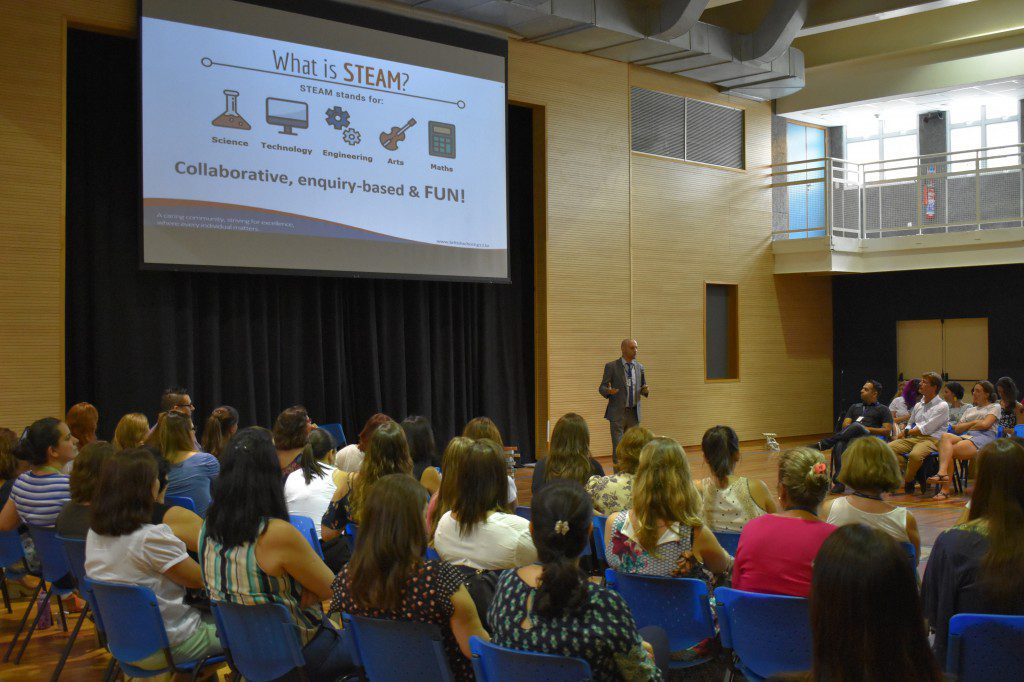STEAM is both an acronym and an educational approach. As an acronym, STEAM stands for Science, Technology, Engineering, Art and Maths. As an educational approach, STEAM is about facilitating learning experiences across these five subject areas, which promote collaboration, enquiry-based learning and fun!
Since the late 1990s there has been an increasing global focus on the need to better prepare students for the 21st century workforce by equipping them with the skills and knowledge in STEAM subjects. After all, the most in-demand jobs globally fall into one or more of these five subject areas.
According to the Rhode Island School of Design, which adds the arts to the original STEM framework, “The goal (of STEAM) is to foster the true innovation that comes with combining the mind of a scientist or technologist with that of an artist or designer.” All technology begins and ends with some form of art. In fact, the arts and sciences are a natural match when students have sufficient time for project development, reflection and revision. For example, arts are used in website and user interface design, advertising and the design of literally any product imaginable.
Many schools around the world, my own included, have made inroads in teaching STEAM through various initiatives, including (but not limited to):
- using Computing & ICT to permeate across the whole school curriculum, thereby linking these five disciplines
- after-school makerspace clubs or programs
- holistic, thematic curricula such as the IPC or PYP, where projects using STEAM practices are embedded
- BYOD initiatives (bring your own device)
- staff training to encourage hands-on exploration within each of these disciplines
- robotics programs
The STEAM approach is intended to be holistic, bringing these five disciplines together. The key to STEAM’s success though, is to ensure that an enquiry-based learning model is followed:
“Studies comparing learning outcomes for students taught via project-based learning versus traditional instruction show that when implemented well, problem-based learning (PBL) increases long-term retention of content, helps students perform as well or as better than traditional learners in high-stakes tests, improves problem-solving and collaboration skills, and improves students’ attitudes towards learning.” (Vega, 2012)

Introducing littleBits…
For this reason, I’ve been happy to get my hands on the littleBits STEAM set below:

littleBits are small, simple, intuitive blocks that make working with electronics a matter of snapping small magnets together with no experience required. The littleBits STEAM Student set is the easiest and fastest way to create imaginative electronic devices and solutions to everyday challenges. Thanks to this colour coding system, no prior knowledge of electronics or circuitry is required, making the kit open to learners of all ages.
I had a go at creating an art machine using the STEAM Student Set, and I was pleased with the results:
Activities like this are a great example of what STEAM learning is all about. It’s clear that children need to be engaged in learning, and learn in ways that can hold their attention, much the same way that social media, and internet sites like Youtube do. Making learning fun and meaningful is the necessary challenge all educators must take on.
In order to further facilitate teaching and learning of STEAM, we are currently building a website, Classroom Flipped, to bring together an online suite of web apps, videos and sites, which have been mapped to our school curriculum. The name, Classroom Flipped, comes from the educational approach known as flipped learning, whereby students interact with educational content outside the classroom to better support their learning inside the classroom. The website includes a section specifically for STEAM, with links to the best resources on the Web, including relevant high quality, age-appropriate educational videos, games, articles and interactive quizzes.
STEAM is not just about using digital technologies though; STEAM activities can be as simple as just using a piece of paper. For example, below is one of the activities we gave our staff was to do when introducing what STEAM is all about:
STEAM Challenge
- Build the highest possible tower you can that holds a book at least 16 cm above the ground for a minimum of 3 seconds (the book must rest on top of the tower)
- The tower must be free-standing, which means no taping or holding to the floor.
Time: 20 minutes (including testing)
Materials: 10 sheets of newspaper and
50 cm of tape,
Group Size: Maximum of 4 people
Success Criteria – The tallest tower wins as long as….
- Tower is free-standing
- Tower is able to hold the weight of a book for a minimum of 3 seconds
- Book must be resting a minimum of 16cm above the ground
- Tower is constructed solely of newspaper and masking tape


Concluding thoughts…
By engaging students around the subjects of Science, Technology, Engineering, Arts and Maths (STEAM) through practical projects, we can spark an interest and lifelong love of the arts and sciences in children from an early age. The littleBits STEAM set is a great place to start, but activities can just be as simple as using paper! The important point is that it is only by teaching relevant, in-demand skills, that we will better prepare our students to become innovators in an changing world.



